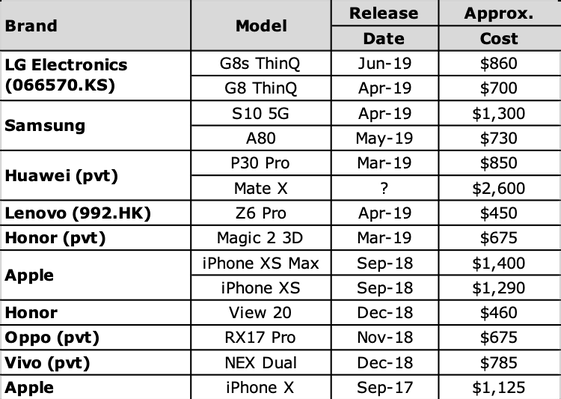Vertical Divider
|
Samsung Doubles Down on ToF Technology
July 01, 2019 Samsung Electronics plans to push Time of Flight (ToF) ‘camera’ (really a sensor) that sends out a beam of infrared light (invisible) from a laser (VCSEL usually), which is reflected by surrounding objects and captured by a sensor. As the speed of light is a constant, measuring the time it takes for the light to reach the sensor can give distance measurements down to the centimeter level, which can be combined with other camera or sensor data to adjust focus on objects that can be individually isolated. Apple was the first smartphone brand to use the technology in late 2017 on the iPhone X, and followed up on the iPhone XS/Max in late 2018 along with three Chinese smartphone brands. This year, the technology has become more popular and has been adopted by a number of other popular brands including Samsung Electronics, which uses it on theS10 5G and most recently on the lower priced, Galaxy A80. TOF will also be included in the upcoming Galaxy Note 10 to be released later this summer. Samsung buys the complete module rather than individual components, which has been supplied by Partron, but is looking to expand its supplier list as it releases the Galaxy Note and potentially other models that will include TOF. |
|
Samsung Electro-Mechanics, Cammsys and Power Logicshave supplied cameras to Samsung, are looking to be added to the TOF supplier list, and MCNEXhas recently committed to building a $11m new plant in Vietnam to produce TOF modules which they expect to open later this summer. TOF is fast, small, and less expensive than most other systems for measuring depth, which is why it is attractive to smartphone designers, however the data it produces can be the basis for software that can enhance, modify, or ‘animate’ camera or recoded images. Because the sensor is fast, the system can be used for AR applications, allowing objects or images to be overlaid on moving video. As this technology develops, we expect to see more applications that use TOF’s ability to compute depth information to manipulate both static and moving images. As such precise depth information can be used to set up software commands that can look for ‘all objects more than 12” from the camera’ or ‘change the color of all objects between 3’ and 6’ from the camera’, the potential is endless. That said, we don’t expect TOF to replace other forms of identification en masse, but to act as an adjunct, increasing accuracy and condition flexibility.
Table 1: Smartphones w/TOF Capability
Table 1: Smartphones w/TOF Capability
Source: GSMArena, Company Data
|
Contact Us
|
Barry Young
|

